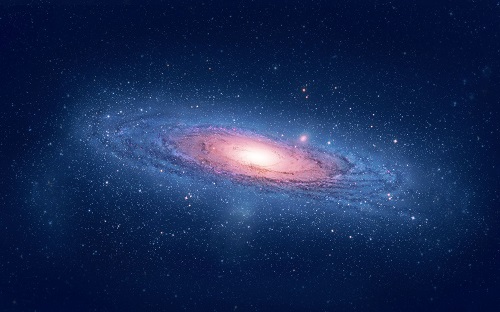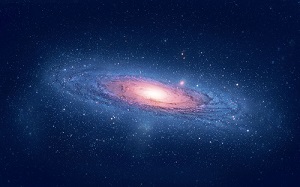Back in January 2011 I wrote about contact between Homo sapiens and Homo neanderthalensis in Neanderthals r us as modern humans moved out of Africa about 45,000 years ago. I was troubled by the lack of mention of Australian Aborigines in the article the post was based on. At the time, from memory, it was thought that Australian Aborigines had been here 10,000 years earlier than that. Continue reading Pushing back the African exodus
Category Archives: Science
Dark matter – forget it!

For a change of pace, this is about the universe and everything.
Supposedly dark matter makes up 80% of the universe, yet no-one has ever seen even a little bit of it.
The time has come to give up on the idea altogether, according to Mordehai Milgrom in an interview with Marcus Chown for the New Scientist (paywalled, but Google him and you’ll find plenty).
Dark matter was inferred to explain the movement of stars in a galaxy. Stars at ever greater distance from the centre should move more slowly because there is less gravity, according to Newtonian physics. But that doesn’t happen. The reason hypothesised is that each galaxy is embedded in a ‘halo’ of dark matter which enhances gravity at the outer regions.
Problem is, there is no consistency. Each galaxy needs its own arbitrary quantum of dark matter distributed in a unique way to explain what actually happens.
Moreover there is no predictive power in the theory.
Among other things, it predicts that we should see many more dwarf galaxies orbiting our Milky Way than we actually do.
I wonder if he means stars.
Milgrom has been on the case for quite a while and in 1981 came up with his alternative modified Newtonian dynamics (MOND) concept. He says:
The meagre data we had then could be explained if at a critical acceleration – a mere hundred billionth of a g – gravity switched from a type that weakens in line with the familiar Newtonian law to a type that falls off more slowly, following a different law. That alternative law is MOND.
He published three papers on his theory which were met with silence.
He says dark matter is the hypothesis of least daring. Just tip in some gravitating stuff that gives out no light. MOND appalled people because it tampered with the basic laws of physics. To be taken seriously it needed to be made compatible with Einstein’s principles of relativity.
This had to wait for one Jacob Benkenstein in 2004. He came up with a theory known as TeVeS (tensor-vector-scalar).
TeVeS describes gravity with three fields and made MOND compatible with Einstein’s relativity. After it was introduced, people started to take MOND more seriously.
Is MOND more elegant than dark matter?
It is certainly far more economical. For every galaxy, dark matter theorists must fit a made-to-measure amount and distribution of dark matter. So, if we understand 10 galaxies, we still don’t understand an 11th. Dark matter explains only after the fact. MOND predicts things ahead of time. This is key.
Also:
A single MOND formula perfectly describes every spiral galaxy, even though the birth of each one is chaotic, complex and unique. It is hard to see how the dark matter model can explain this.
Literally hundreds of MOND predictions have been vindicated and some 700 papers on the theory have been published in the last few years.
So if you hear about dark matter, unless the story is that the stuff has finally been found, take it with a grain of salt. It’s an old idea that doesn’t work very well. If you hear about MOND, then listen carefully, we could be getting closer to a theory of the universe and everything.
Just for fun here’s Andromeda Galaxy:

A bolt from the blue
As you know I’m always up for a thread of doom, so when I heard talk of asteroid strikes happening more frequently than previously thought I decided to investigate.
The story starts with an asteroid that exploded in the air in the Chelyabinsk region in February 2013. There was a collection of videos at Slate. Car alarms were set off by the shock wave, but I gather most of the damage came from broken glass. Over 1000 people were injured. There are some stills of damage here.
The rock was about 19 metres across (equivalent to a six-story building), with a mass of about 12,000 tons. When it hit the atmosphere at a speed of 20 kilometers per second (many times faster than a rifle bullet) the energy released was equivalent to about 500,000 tonnes of TNT, and the brightness around 30 times that of the sun.

This Slate article has a description of what happened physically. Broadly:
It came in over Russia at a low angle, slamming into our atmosphere, violently compressing the air in front of it. That created a vast amount of heat and pressure, which simultaneously melted and broke up the asteroid into smaller fragments. Within seconds, the huge energy of motion of the rock was suddenly and violently dissipated, creating an explosion equal to about 500,000 tons of TNT detonating.
I think 500,000 tonnes of TNT is about the equivalent of 40 Hiroshima bombs.
As that article says (see also the BBC and the ABC) asteroid strikes are now thought to happen more frequently than previously thought (paywalled research here and here), perhaps as much as ten times more. Chelyabinsk-type events were thought to happen every 150 years on the average. Now the estimate has moved to every 25 to 30 years. And then there’s all the others in the range from say 1 to 50 metres. Previously we relied on visual records, but some, over the sea, for example, have escaped notice.
Apparently there are literally millions of objects in the tens-of-metres-of-size range that could come near Earth and we only know about 1000. Continue reading A bolt from the blue


